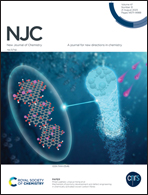Copper phosphide–phosphorus (Cu3P/P) hybrid nanomaterials: an in situ dioxygen activator in ambient aqueous conditions for advanced oxidation process†
Abstract
To date, a great deal of interest has been focused on economical and environmentally friendly advanced oxidation processes (AOP) for the degradation of organic pollutants. Herein, the green synthesis of copper phosphide–phosphorus (Cu3P/P) hybrid nanomaterials was achieved via a one-pot method using sodium phosphathynolate (NaOCP) as the phosphorus precursor in this study. The resulting Cu3P/P exhibits remarkably high degradation activity as a catalyst in advanced oxidation processes (AOPs) for sulfamethoxazole (SMX) in neutral aqueous solution in the absence of additional oxidants and external energy. The spontaneous generation of O2˙−, H2O2 and ˙OH was detected in these AOPs. The experimental results show that Cu3P/P first reduced dioxygen to generate O2˙−, O2˙− reacted with water to further produce H2O2, and H2O2 and Cu(I) on the surface of Cu3P/P underwent a Fenton-like reaction to generate ˙OH. Under the synergistic effect of O2˙− and ˙OH, the degradation of SMX reached 100% in 10 minutes. In addition, the good recyclability and low Cu ion leaching in the AOPs suggest that the Cu3P/P nanomaterial is a promising catalyst for practical application.



 Please wait while we load your content...
Please wait while we load your content...